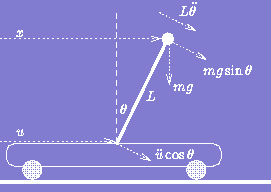 home page
home page Broom balancing as a control problem
Broom balancing as a control problem
This is home page for the course of 16 lectures that was taught over 8 weeks in winter 2001 to final year Cambridge mathematics students. Lectures are 10 am Wednesdays and Fridays in MR3.
The diagram of the trolley on wheels at the top of this page models the problem that a juggler has when she tries to balance a broom upright in one hand. In this course you will learn how to balance N brooms simultaneously on top of one another, or perhaps side by side. Can you guess which of these two juggling trick is more difficult?
Each lecture is as self-contained as possible and has course notes amounting to four A4 pages. Click here for the table of contents.
There are 3 examples sheets, with solutions, each containing about 12 questions, and also further 3 sets of supplementary questions. You should receive a supervision on each examples sheet. There is a file of past exam questions. There are four recommended books.
Please send me email with comments or corrections on my lectures, the notes or the examples sheet. I am very glad to receive comments and suggestions from students studyng the course.
This material is provided for students, supervisors (and others) to freely use in connection with this course. Copyright remains with the author. Notice to external persons accessing this page
Course notes
There are 74 pages of notes [contents (4), notes (68), index (2)].
How to view and print: The notes are in postscript and in Adobe Acrobat format (pdf files). Most computers have an Acrobat viewer installed, and if yours does not, one can be obtained for free. Acrobat provides for printing and display on a wide variety of devices.
When you click below, you should begin to view the file on your screen with Acrobat. You can then mark and print the specific page or pages you require, rather than waste paper by printing all the pages. Ideally, you will want to print to a 600 dpi laser printer, but 300 dpi will do.
The notes have been prepared in two versions:
In the first version, L.ps or L.pdf, there is one page of notes per A4 page. In the second version, L2.ps or L2.pdf, there are two half-sized pages per A4 landscape page (which is the format handed out in lectures). Each lecture begins on an odd numbered page, so there are a few blank half pages.
In the postscript version, the notes are formatted as two side-by-side pages per A4 sheet. So to view the notes properly you may need to go to the ghostview menus and set the display for A4 paper in landscape mode.
You can access this material either in Parts or in small lecture by lecture chunks.
toc.ps,
PartI.ps: [
L01.ps,
L02.ps,
L03.ps,
L04.ps,
L05.ps,
L06.ps ] ,
PartII.ps: [
L07.ps,
L08.ps,
L09.ps,
L10.ps,
L11.ps ] ,
PartIII.ps: [
L12.ps,
L13.ps,
L14.ps,
L15.ps,
L16.ps ] ,
index.ps.
Corrections: Whenever I find an error in the notes the files above are corrected and a note is added to this list of corrections. Here are some additional notes which summarise things I said in lectures and which do not appear in the printed notes. I have also made notes about questions that students asked, either in lectures or by coming up to me afterwards.
What to know
The files below contain brief summaries of the key results you need to
know for each of the three parts of the course, and glossaries of
keywords and notation
for each part.
summary1.pdf, summary2.pdf, summary3.pdf.
Where to collect photocopies of the notes: I will hand out printed notes lecture by lecture. You can also download them from this site. You can also find copies of the notes by using this map to locate the Statistical Laboratory pigeonholes.
Examples Sheets
There are 3 examples sheets available as postscript and pdf files.
Model solutions will be handed out following supervisions. Once
again, these are available full size:
exsheet1.ps,
exsheet2.ps,
exsheet3.ps.
or half size: exsheet12.ps, exsheet22.ps, exsheet32.ps.
exsheet1.pdf, exsheet2.pdf, exsheet3.pdf, or half size: exsheet12.pdf, exsheet22.pdf, exsheet32.pdf,
Corrections:
Whenever I find an error in the examples sheets the files above are
corrected and a note is added to this
list of corrections.
Recommended books
Here are past tripos questions 1995-2000, again in various formats: tripos.ps, tripos2.ps, tripos.pdf, tripos2.pdf, and solutions.ps, solutions2.ps, solutions.pdf, solutions2.pdf.
It is in your own interest to refer to the solutions only after
you have made serious attempts at producing your own model answers.
To read this file too soon, eliminates an important resource that you
will want to use for practice.
Other items of interest
Here is what the Occupational Outlook Handbook says about
careers in operations research.
Here is Michael Trick's Home Page, a great place to find out lots more about operations research.
Here is the home page of INFORMS, the Institute for Operations Research and the Management Sciences.
My fun page.
 home page
home page